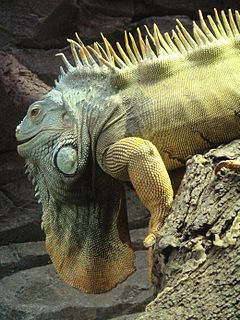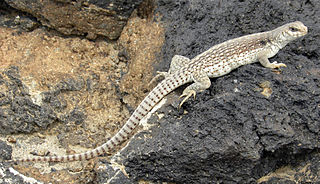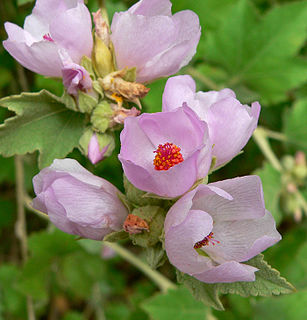
Kingsnakes are colubrid New World members of the genus Lampropeltis, which includes milk snakes and four other species. Among these, about 45 subspecies are recognized. They are nonvenomous and ophiophagous in diet.

The Iguanidae is a family of lizards composed of the iguanas, chuckwallas, and their prehistoric relatives, including the widespread green iguana.

The Channel Islands are an eight-island archipelago located within the Southern California Bight in the Pacific Ocean, off the coast of California. The four Northern Channel Islands are part of the Transverse Ranges geologic province, and the four Southern Channel Islands are part of the Peninsular Ranges province. Five of the islands are within the Channel Islands National Park, and the waters surrounding these islands make up Channel Islands National Marine Sanctuary. The Nature Conservancy was instrumental in establishing the Channel Islands National Marine Sanctuary. The islands were inhabited as early as 13,000 years ago, the earliest paleontological evidence of humans in North America. They are the easternmost islands in the Pacific Island group.

Dipsosaurus is a genus of lizards in the family Iguanidae.

The island fox is a small fox that is endemic to six of the eight Channel Islands of California. There are six subspecies, each unique to the island it lives on, reflecting its evolutionary history. They are generally docile, show little fear of humans, and are easily tamed. Island foxes played an important role in the spiritual lives of native Channel Islanders. They have been likely semi-domesticated as pets, used as pelts, or for other functions, like pest control.

The California quail, also known as the California valley quail or Valley quail, is a small ground-dwelling bird in the New World quail family. These birds have a curving crest or plume, made of six feathers, that droops forward: black in males and brown in females; the flanks are brown with white streaks. Males have a dark brown cap and a black face with a brown back, a grey-blue chest and a light brown belly. Females and immature birds are mainly grey-brown with a light-colored belly. Their closest relative is Gambel's quail which has a more southerly distribution and a longer crest at 2.5 in (6.4 cm), a brighter head and lacks the scaly appearance of the California Quail. The two species separated about 1–2 million years ago, during the Late Pliocene or Early Pleistocene. It was selected as the state bird of California in 1931.

The desert iguana is an iguana species found in the Sonoran and Mojave Deserts of the Southwestern United States and northwestern Mexico, as well as on several Gulf of California islands.

The Santa Catalina rattlesnake is a species of venomous pit viper endemic to Isla Santa Catalina in the Gulf of California just off the east coast of the state of Baja California Sur, Mexico. No subspecies are currently recognized. A relatively small and slender species, its most distinctive characteristic is that it lacks a rattle.

The Catalina Island Conservancy is a nonprofit organization established to protect and restore Santa Catalina Island, California, United States. The Conservancy was established in 1972 through the efforts of the Wrigley and Offield families. The Conservancy was created when both families deeded 42,135 acres (170.51 km2) of the island over to the organization—88% of the Island.
Slevin's mouse, also known as the Catalina deer mouse, is a species of rodent in the family Cricetidae. It is endemic to Isla Santa Catalina off the east coast of Baja California Sur, an island with an area of about 40 km2 (15 sq mi), and it is the only native mammal on the island. It is named for Joseph Slevin, a curator at the California Academy of Sciences.

Santa Catalina Island is a rocky island off the coast of Southern California in the Gulf of Santa Catalina. The island name is often shortened to Catalina Island or just Catalina. The island is 22 mi (35 km) long and 8 mi (13 km) across at its greatest width. The island is located about 29 mi (47 km) south-southwest of Long Beach, California. The highest point on the island is Mount Orizaba. Geologically, Santa Catalina is part of the Channel Islands of California archipelago and lies within Los Angeles County. Catalina Island is the easternmost of the Channel Islands. Politically, Catalina Island is part of Los Angeles County in District 4. Most of the land on the island is unincorporated with 90% of the population living in the city of Avalon.

Malacothamnus fasciculatus, with the common name chaparral mallow, is a species of flowering plant in the mallow family. It is found in far western North America.

Austrotrophon catalinensis is a species of sea snail, a marine gastropod mollusk in the family Muricidae, the murex snails or rock snails.

Austrotrophon is a genus of sea snails, marine gastropod mollusks in the family Muricidae, the murex snails or rock snails.

Sagartia is a genus of sea anemones in the family Sagartiidae. The genus was first described by Philip Henry Gosse in 1855 and the image is his painting of several species found in British waters included in his book, A history of the British sea-anemones and corals.
Odostomia catalinensis is a species of sea snail, a marine gastropod mollusc in the family Pyramidellidae, the pyrams and their allies.
Melanella catalinensis is a species of sea snail, a marine gastropod mollusk in the family Eulimidae. The species is one of many species known to exist within the genus, Melanella.
Isla Santa Catalina, officially known as Isla Catalana, is an island in the Gulf of California east of the Baja California Peninsula. The island is uninhabited and is part of the Loreto Municipality.
Isla San Luis is an island in the Gulf of California east of the Baja California Peninsula. The island is uninhabited and is part of the San Felipe Municipality.
Hylaeus polifolii is a species of hymenopteran in the family Colletidae. It is found in North America.











